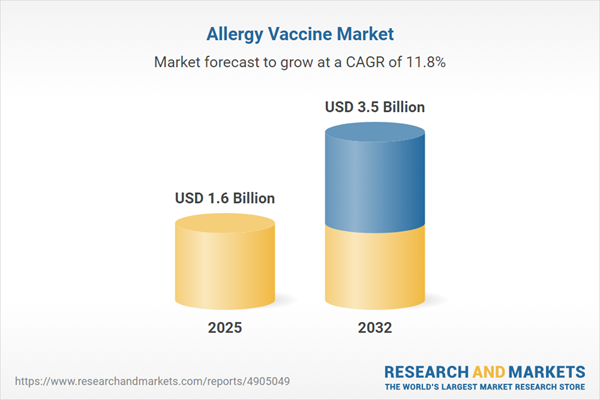Speak directly to the analyst to clarify any post sales queries you may have.
The allergy vaccine market is evolving rapidly, shaped by scientific advances, regulatory change, and shifting patient needs. This report provides actionable insights for senior decision-makers seeking to optimize strategy in the allergy immunization sector.
Market Snapshot: Allergy Vaccine Market Size & Growth
The Allergy Vaccine Market grew from USD 1.43 billion in 2024 to USD 1.60 billion in 2025. It is expected to continue growing at a CAGR of 11.84%, reaching USD 3.50 billion by 2032. Ongoing market expansion is fueled by breakthroughs in immunobiology, enhanced delivery platforms, and evolving global health priorities. Increasing collaboration across key stakeholders is optimizing development and accelerating patient access to immunotherapy solutions.
Scope & Segmentation of the Allergy Vaccine Market
This research report examines the allergy vaccine sector through comprehensive segmentation, capturing changing trends, therapies, and markets worldwide.
- Route of Administration: Subcutaneous immunotherapy (accelerated and standard doses); sublingual immunotherapy (drops and tablets)
- Allergens Targeted: Perennial allergens (animal dander, dust mite); seasonal allergens (molds, pollen)
- Vaccine Type: Monovalent, polyvalent
- Distribution Channel: Hospital pharmacies, online pharmacies, retail pharmacies
- Technology: Recombinant, traditional extract
- Patient Age Group: Adult, geriatric, pediatric
- End User: Clinics, home healthcare, hospitals
- Regional Coverage: Americas (North America, Latin America), Europe, Middle East & Africa, Asia-Pacific
- Key Companies Included: ALK-Abelló, Stallergenes Greer, Allergopharma, Merck & Co., DBV Technologies, Allergy Therapeutics, Laboratorios LETI, HAL Allergy, Bencard Allergie, Torii Pharmaceutical
Key Takeaways and Strategic Insights
- Recent scientific progress, such as recombinant antigen engineering and advanced adjuvant systems, is transforming vaccine formulation and improving safety profiles.
- Operational agility is required as regulatory frameworks adapt to novel delivery modes like sublingual and needle-free platforms, supporting differentiated patient engagement strategies.
- Digital tools, telemedicine, and real-world evidence collection are supporting treatment adherence, monitoring, and iterative therapy optimization.
- Market segmentation by allergen, patient demographic, and administration route enables tailored portfolios that resonate with diverse clinical needs.
- Strategic partnerships between established biopharma organizations and emerging biotech innovators are shaping a balanced, competitive ecosystem across global and local markets.
Tariff Impact and Supply Chain Strategies
Recent U.S. trade duties on raw materials are compelling manufacturers to revisit sourcing and supply chain logistics. Adjustments include negotiating with domestic suppliers, exploring alternative materials, and reassessing regional production footprints. These responses are intended to manage cost variability and protect product quality. Regulatory guidance for clinical trial materials and collaborations across industry groups are helping mitigate tariff effects and strengthen resilience.
Methodology & Data Sources
This report uses a structured, multi-layered research methodology. Primary data were gathered from immunology experts, regulatory professionals, and supply chain leaders. Secondary sources included scientific publications, patents, clinical trial registries, and regulatory documentation. Analytical techniques such as scenario modeling, sensitivity analysis, and peer review reinforce data integrity and actionable insight.
Why This Report Matters to Decision-Makers
- Enables strategic planning by delivering current, segmented market intelligence on allergy immunotherapy
- Supports investment and operational decisions with deep analysis of regulatory trends, supply chain risks, and new technologies
Conclusion
This research highlights the strategic imperatives that define success in the evolving allergy vaccine domain. By leveraging robust data and forward-looking insights, stakeholders are equipped to meet emerging challenges and capitalize on market opportunities.
Additional Product Information:
- Purchase of this report includes 1 year online access with quarterly updates.
- This report can be updated on request. Please contact our Customer Experience team using the Ask a Question widget on our website.
Table of Contents
3. Executive Summary
4. Market Overview
7. Cumulative Impact of Artificial Intelligence 2025
Companies Mentioned
The companies profiled in this Allergy Vaccine market report include:- ALK-Abelló A/S
- Stallergenes Greer LLC
- Allergopharma GmbH & Co. KG
- Merck & Co., Inc.
- DBV Technologies S.A.
- Allergy Therapeutics plc
- Laboratorios LETI, S.L.
- HAL Allergy B.V.
- Bencard Allergie GmbH
- Torii Pharmaceutical Co., Ltd.
Table Information
| Report Attribute | Details |
|---|---|
| No. of Pages | 187 |
| Published | November 2025 |
| Forecast Period | 2025 - 2032 |
| Estimated Market Value ( USD | $ 1.6 Billion |
| Forecasted Market Value ( USD | $ 3.5 Billion |
| Compound Annual Growth Rate | 11.8% |
| Regions Covered | Global |
| No. of Companies Mentioned | 11 |









